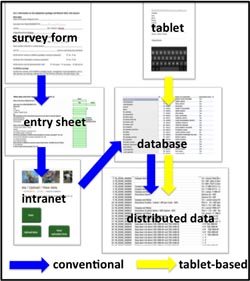Fred Kanampiu selected this because as a learning grant, it is key to ensure timely feedback to generate and document learning to steer the implementation of the project. Having an up to date information from the field has contributed to the learning process of the project. This article appeared first in Podcaster 30, March and April 2015.
Learning plays a central role in N2Africa. The success of our dissemination approaches depends on the ability to determine what works, where how and for whom and to adapt activities accordingly. Key to this process of learning, is a system of data collection, management and delivery that ensures that data is captured from the field and converted into an accessible form as quickly and accurately as possible. N2Africa has worked hard to establish such a system and we are happy to report on recent proress and future plans for improvement.
|
Our data flows are organized in the following way: our partners use paper survey forms to collect data from the field. The information on these forms is passed on to special Excel forms that are easy to fill and provide a uniform template for data processing. In each country, the responsible data manager collects these forms and uploads them to the N2Africa intranet. From that moment on, the data is centrally stored and backed-up for safety and can be downloaded by all N2Africa staff with an intranet account. Data on the intranet is subsequently checked for consistency and completeness and read into the N2Africa central database. The database is the central point of storage and access for data in N2Africa. All information in the database can be written to Excel workbooks that can be downloaded by N2Africa staff and used in further analysis (Figure 1). Figure 1: Current and tablet-based data flows |
|
In 2014, this system of data flow was implemented successfully and all countries having contributed data that is now accessible through the intranet. Some of this data was already analysed and the results shared with the country teams. This experience has also taught us some valuable lessons for improvement. The first lesson is that the time and effort involved in passing data from paper to the computer can be a burden on N2Africa staff and partners. It also can lead to delays in data entry, meaning that data is not available for analysis before the next season starts. Another point of improvement is the complexity of the survey forms, which can lead to incomplete and inconsistent data.
With these points in mind, we have undertaken several steps to improve data collection and management in 2015. First, the field books for demonstration and diagnostic trials were greatly reduced and simplified, thanks in large part to the very useful feedback from field staff and partners in the different countries. Second we are starting to implement tablet-based data collection using Open Data Kit (ODK) forms in all countries. Tablet-based data collection has the advantage that it eliminates the need for separate paper forms and electronic data entry sheets (Figure 1). Data is collected directly on a hand-held electronic device and automatically sent to the central database, thereby greatly reducing data turnover time. An added advantage is the possibility to include pictures and to take GPS coordinates directly on the device.
A tutorial document was distributed and a simple training session using the ODK survey form for Focal Adaptation trials was successfully concluded. For 2015, we are aiming to move data entry increasingly to tablet-based capture using ODK. We are looking forward to working together with all N2Africa staff and partners to make this transition a success and together achieve even higher standards of data quality and a more timely delivery.
Joost van Heerwaarden

